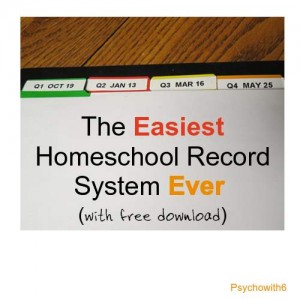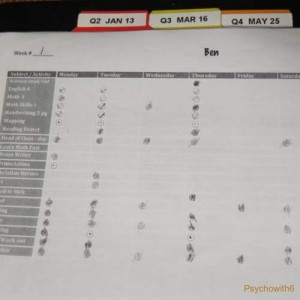You’re really busy homeschooling. You don’t need a record keeping system that makes extra work for you. In fact, you’d love a system that your kids can use independently. I have just such a system and it’s FREE. Interested? Read on.
I Tried it All
I’ve been keeping homeschool records for nine years for as many as five of my six children at a time. I’ve tried something different every one of those nine years. My goal was to not only keep track of my children’s work for legal purposes, but to give my children their assignments to work on independently.
I’m a technology lover, so I was sure that one of the digital record software programs would work for me. But every one of them resulted in:
- Long hours inputting data for up to five children
- Time-consuming adjustments to the schedule when work was missed
- My having to approve each student’s completed assignments
While I think some of these programs could have worked for me if I had fewer children, I found myself incredibly frustrated.
Things improved when I switched to paper record keeping. I kept a record of all group activities. The kids had one general schedule of what to do each day. The problem was I was still responsible for all the record keeping and having to ask each child what he got done.
The Linda Hobar Way
I was wondering what other changes I could make to improve my record keeping when a friend told me about Linda Hobar’s method. (Linda is the author of the Mystery of History curriculum.) Here’s the gist of it:
- Each school year is divided into quarters
- Work that is expected for each quarter is put behind a binder tab
- Students can work ahead on preferred subjects, but must complete all work by the end of the quarter
I decided to combine her advice with some principles that worked for me. I created a weekly form listing each subject/book on the left. Rather than assigning specific page numbers as I had done in the past, I was assigning one lesson or page per day, unless I indicated otherwise (e.g., Handwriting, 2 pgs.). The days of the week were indicated in columns on the right. I used check boxes to indicate how many times a week that I expected the work to be done (and suggested days on which to do it). I left an Other section for indicating activities not regularly scheduled.
I created forms and a binder with dated quarterly tabs for myself and each of the kids. Rather than use check boxes to indicate a certain time period, I chose to plan how much time a subject would require in advance. In other words, a science lesson would take an hour whereas handwriting would only take 15 minutes. Including the group activities that I track, I made sure that each child would more than enough activities to meet the hourly requirements for the end of the year for my state. This eliminated the time I had to spend adding up hours for each child.
The end result is my children love it and so do I. They’ve become completely independent in completing their school work. I throw in some extra motivation to get done with a quarter by promising to take everyone out for a treat.
I’d like to give you a treat, too! I have a free template in Word for you to make your own homeschool forms. If you take the summer off and you’d like to give this approach a try before next fall, you might consider creating a summer binder of work you’d like the kids to complete to stay fresh.
Do you have any other suggestions for making record keeping easier?
Dr. Melanie Wilson is a Christian psychologist turned homeschooling mother of six. She shares sanity-saving ideas for homeschooling and life (including a free meal-planning ebook) on her blog, Psychowith6.













I wasn’t able to download the free Word spreadsheet. Can you help?
Denise, I will email you. Thanks so much for letting me know.
Can’t download the spreadsheet either :=(
Lorrie, I emailed you. 🙂
Do you have a Mac friendly version? or pdf?
Misty, I created the form using Word for Mac, but I don’t have it in Pages or in an editable PDF. However, you should be able to use Open Office. Hope that helps!
Melanie,
This was my favorite post to read this summer. Am working on my planning this year and this way just seems so logical. . .take the big picture and break it down into bite-sized pieces.
Thanks so much!
Erin, you made my day. Thanks for the comment. I’m still using the system which says a lot if you knew me. 🙂
I can’t seem to get the link to work. Any ideas?
Jenny, there was a problem on my end. Should be working for you now. Here’s the direct link: http://wp.me/P2M4mD-D2
Thanks for sharing! I also have 6 children, but am only doing school work with 2 (sometimes 3) at a time right now. My youngest 3 are under 2 years old (set of twins 22 mo. and a 7 month old) so my biggest challenge is to get tasks completed with little ones running around!
Thank you for this! I rarely comment on blogs, but wanted to comment because this is exactly what I’ve been looking for! Thank you so much!
Yay, Hilary!
This was such a blessing! I’ve had this picture in my mind but you put it directly on paper and made it editable! Thank you so much!
Can you email the link to me.Thanks
Hello,
I am not sure what I am doing incorrectly but the link will is sending me in cyber circles. I am trying to get the portfolio printables.
Thank you